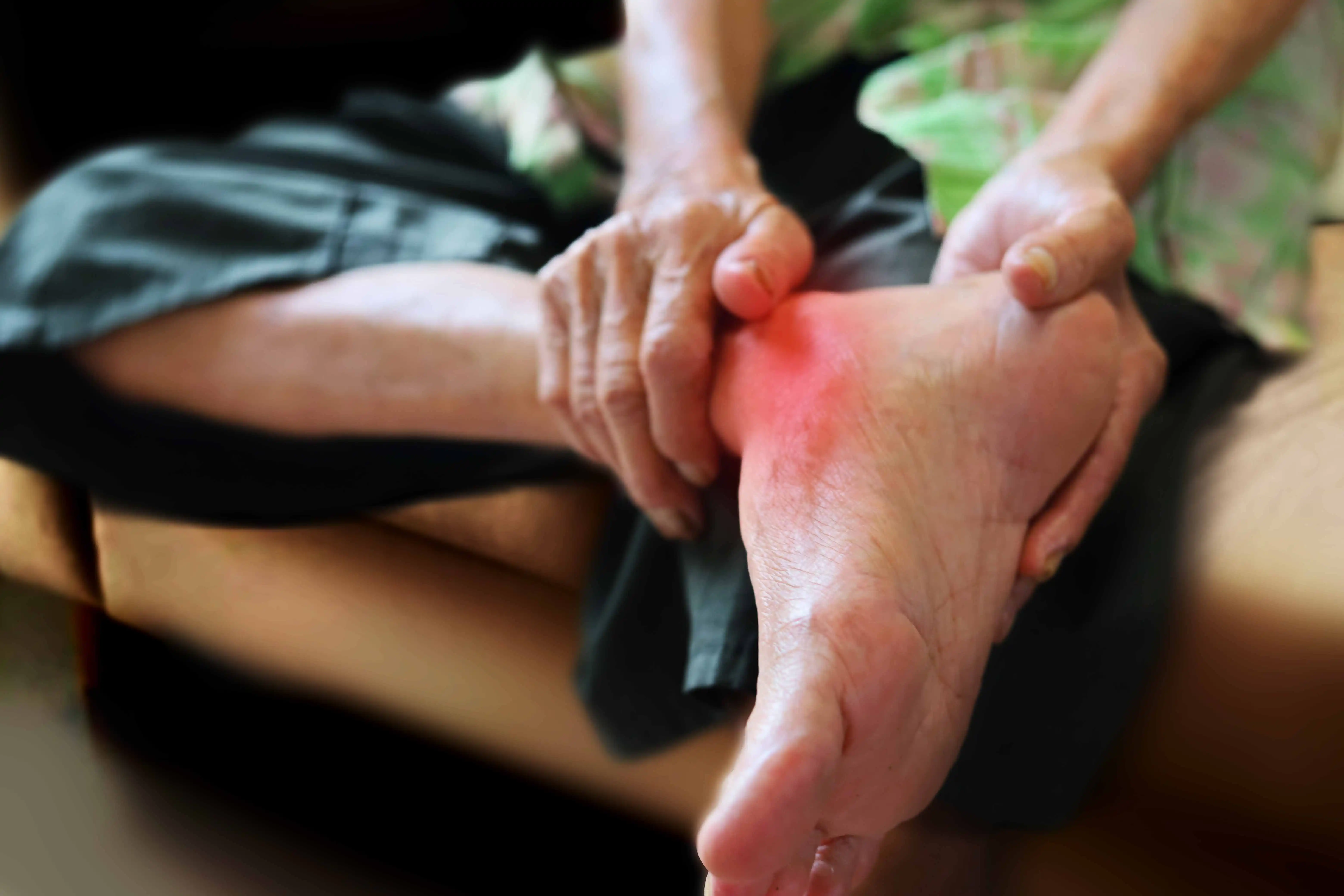Ankle pain is definitely not a walk in the park; unfortunately, it can happen to anyone, no matter how old you are. Whether you’re an active athlete pushing your limits or someone who spends long hours on their feet, ankle pain can strike when you least expect it. The good news is that seeking immediate ankle pain treatments can really make a difference! It can help stop further damage and improve your overall quality of life.
In this blog, we’ve summed up causes, symptoms, diagnosis, and ankle pain treatment options that might benefit.
What is Ankle Pain?
Your ankle joint consists of three bones – the tibia, fibula, and talus – and it’s got a bunch of other elements like ligaments, tendons, and muscles keeping it all together.
This combination allows you to move your foot up and down and side to side. If there is any obstacle or hindrance in its operation, it could result in discomfort or pain in our foot or ankle.
Causes of Ankle Pain

Various factors cause ankle pain, and identifying the underlying cause is crucial for proper ankle pain treatment and management.
Here are a few causes leading to ankle pain:
- Injuries such as sprains, strains, and fractures.
- Arthritis, including osteoarthritis and rheumatoid arthritis.
- Tendinitis, which is inflammation of the tendons in the ankle.
- Gout; a form of arthritis that occurs when uric acid crystals accumulate within the joint.
- Nerve damage or compressions, such as in peripheral neuropathy or tarsal tunnel syndrome.
- Infections, such as cellulitis or osteomyelitis.
- Obesity or overuse of the ankle joint.
Symptoms of Ankle Pain
The symptoms of ankle pain may vary depending on the cause of the pain. Common symptoms include:
- Pain, stiffness, or swelling in the ankle joint.
- Difficulty moving the ankle joint.
- Redness or warmth around the ankle joint.
- Tenderness to the touch.
- Tingling or numbness in the toes or foot.
Diagnosis of Ankle Pain

To diagnose the cause of ankle pain, your healthcare provider may perform a physical exam and ask about your symptoms and medical history. They may also conduct imaging tests, such as X-rays, MRI, or CT scans, to get a better view of the ankle joint.
Ankle Pain Treatment Options & Their Potential Risks
If you’re experiencing pain or distress, seeking appropriate ankle pain treatment is essential for relieving discomfort and preventing further damage or complications. The course of treatment can vary significantly depending on the underlying cause and severity.
Treatment options for ankle pain may include:
Over-the-Counter Medication
Ankle pain can be alleviated with medication such as nonsteroidal anti-inflammatory drugs (NSAIDs) that are available over the counter (OTC).
While these medications can help reduce pain, they do not necessarily manage the root cause of the pain.
Doctors may commonly prescribe NSAIDs like ibuprofen, aspirin, and naproxen sodium. These are also available as topical gels that can be directly applied to the area for joint and tissue pain relief.
For moderate to severe pain, doctors may prescribe opioid medications, such as codeine, morphine, and hydrocodone, which come in various forms, including tablets, capsules, injections, and skin patches.
Risk Factor- According to the Food and Drug Administration (FDA), NSAIDs should not be used after the 20th week of pregnancy due to potential harm to the developing fetus.
NSAIDs can effectively treat musculoskeletal pain, including ankle pain caused by arthritis. However, they can also cause severe side effects such as heart attacks, gastrointestinal problems, and allergic reactions.
While opioids can be helpful for short-term pain relief, you should only take them under medical supervision due to the risk of adverse consequences and potential misuse.
Braces
Medical professionals may recommend alternative options when home remedies and over-the-counter treatments fail to alleviate ankle pain. One possible ankle pain treatment solution is braces, aiding injury recovery and prevention by limiting motion and reducing pain.
Risk Factor- Wearing an ankle brace could reduce strength and balance in the affected ankle. In such circumstances, it may be beneficial to undergo physical therapy and rehabilitation exercises to mitigate these effects. Moreover, it is essential to choose the appropriate type of ankle brace.
A study conducted in 2020 involving 2,073 female high school volleyball players with lower extremity injuries revealed that wearing soft-shell braces increased the likelihood of ankle injuries.
Physical Therapy
Regular physical exercise can be an effective way to alleviate ankle pain and stiffness. It is advisable to start with gentle and slow exercises and gradually increase the intensity over time. If the ankles are stiff before exercising, consider taking a warm shower or doing warm-up exercises to loosen up the joints.
Experts suggest avoiding high-impact sports and heavy lifting if following physical therapy as an ankle pain treatment option. Physical activity can help individuals maintain their fitness level, keep other muscles and joints strong and flexible, prevent injury recurrence, and maintain a moderate weight.
Risk Factor- Certain movements may exacerbate ankle pain or result in intense bursts of pain. Therefore, seeking advice from a doctor and physical therapist is essential to determine the most effective approach to resuming physical activity.
Steroid injections
According to a retrospective study conducted in 2017, steroid injections may be beneficial for individuals experiencing ankle pain for up to three months after an injury. Steroid injections work by reducing inflammation and swelling and enhancing pain relief.
Risk Factor- While effective in reducing inflammation and pain, Steroid injections may also result in specific side effects.
These include the following:
- Temporary pain in the injected area,
- Bruising or bleeding at the injection site,
- Skin discoloration or fat thinning, and
- Risk of tendon weakening or rupture.
- Allergic reactions or infections at the injection site may occur.
It is important to consult a professional if any noticeable effects arise after receiving a steroid injection. Moreover, the severity of the side effects may increase with prolonged use of this medication.
Surgery
Severe ankle pain and injury may require surgical intervention. Various surgical procedures may be necessary, including ankle arthroscopy, ankle ligament reconstruction, ankle replacement surgery, and ankle fusion.
- Ankle arthroscopy: The surgeon makes incisions and inserts a small tube consisting of a video camera to examine joints and scar tissue. It may repair torn or stretched tissues.
- Ankle ligament reconstruction: Use tendons from other body areas to repair or reconstruct torn ligaments.
- Ankle replacement surgery: Replaces damaged joint with ankle implant for severe ankle arthritis.
- Ankle fusion: Connects two bones below the ankle with nails, screws, or plates for severe arthritis unsuitable for replacement surgery.
Risk Factor- Ankle surgery carries risks, and the recovery process may include reduced range of motion and swelling.
Complications of ankle surgery may include:
- Bleeding
- Infection
- Damage to tissues like tendons and nerves
- Issues with screws, nails, or plates used in the surgery
- New arthritis affecting nearby bones.
Regenerative Treatment
Regenerative treatment for ankle pain can offer a long-term solution for those who suffer from chronic or acute ankle pain. Unlike traditional treatments such as surgery or medication, regenerative medicine focuses on harnessing the body’s natural healing power to promote tissue repair and regeneration.
If you are looking for a non-invasive, and enduring treatment option for ankle pain, regenerative therapy may be worth considering. With the potential to avoid the risks and downtime associated with surgery and the dependency on medication, regenerative treatments offer a promising alternative to traditional therapies.
Risk Factor- It’s worth noting that the full benefits of regenerative treatments may only become apparent up to six months after the treatment.
What are the Best Home Remedies for Ankle Pain Treatment?

- Rest: Reduce weight-bearing activities and avoid activities that aggravate the pain.
- Ice therapy: Apply an ice pack to the affected area for 15-20 minutes daily to reduce swelling and pain.
- Compression: To help reduce swelling, consider using a compression bandage.
- Elevation: Elevate the affected ankle above the heart level to help reduce swelling.
- Exercise: Gentle exercises can help improve the flexibility and strength of the ankle.
- Weight management: Maintaining a healthy weight can lower the stress level on the ankle joint.
- Anti-inflammatory diet: Eating foods that have anti-inflammatory properties can help reduce pain and inflammation.
- Massage therapy: Massaging the area can help reduce tension and improve circulation.
- Herbal remedies: Some herbs, such as ginger, turmeric, and devil’s claw, may have anti-inflammatory properties and help reduce pain and swelling.
- Acupuncture: Acupuncture can help reduce pain and improve the range of motion in the affected ankle.
How Can I Prevent Ankle Injury?
- Wear proper footwear with good support and cushioning.
- Warm up before physical activity and exercise.
- Strengthen ankle muscles with exercises such as calf raises and ankle circles.
- Practice balance exercises to improve ankle stability.
- Avoid high-impact activities or engage in them with appropriate precautions.
- Maintain a healthy weight.
- Rest and recovery after physical activity or injury.
- Consider using ankle braces or tape for added support during physical activity.
Bottomline
In most cases, you can effectively manage ankle injuries with simple home treatments such as resting and elevating the affected foot. Surgery is typically not required for ankle pain.
However, if the pain is severe, accompanied by significant swelling, or persists for more than a few days, it is advisable to seek medical attention from a healthcare provider. Remember that there are non-invasive treatment options available that can promote long-term healing and improve your mobility. If you seek non-invasive and effective therapy for your ankle pain, consider contacting Regenerative Masters today!


